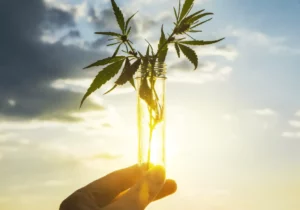I’ve got a pretty rigorous workout schedule causing me a fair amount of muscle pain when I’m done. Would weed topicals be good for this, and how do they work?
Marcy F.

Cannabis-infused topicals would be indeed worth considering for your and other types of pain. They come in a wide variety of forms, such oils, creams, lotions, balms, mud masks, and more. They are all infused with potent cannabinoids, particularly tetrahydrocannabinol (THC) and cannabidiol (CBD), and sometimes terpenes as well.
When cannabis is ingested or inhaled, you can feel the effects quickly throughout your system or in a manner of hours, depending on the method of consumption (for example, smoking vs. edibles). But with weed topicals, the effects are usually just felt locally, on the area where they are applied (in your case, certain sore muscles).
Cannabis topicals work by being absorbed through the skin and binding to our CB2 receptors, which are found throughout the body as part of the endocannabinoid system (ECS). The endocannabinoids (molecules produced by the body) bind to the receptors to achieve effects such as relieving pain, reducing inflammation, boosting the immune system, and much more.
Cannabinoids from cannabis act in much the same way. THC will bind with the ECS receptors in a similar way to the endocannabinoids, to provide pain-relieving and anti-inflammatory effects. CBD also reacts with the ECS without THC’s psychoactive effects. While it doesn’t bind to the same receptors as THC, it may work by preventing endocannabinoids from being broken down, so they have more of an effect on your body.
Many people turn to topicals for ordinary aches and pains, such as sore, tense or injured muscles. The cannabinoids seep into the skin, and help to ease tension while providing localized pain relief. Marijuana’s anti-inflammatory effects also help reduce pain and inflammation at the site of any sprained, pulled or injured muscle. Topicals are also sometimes applied to arthritic joints to provide pain relief
ArnisB
Another thing that needs to be pointed out is that THC is particularly potent when it comes to fighting pain, but some people might avoid it because they don’t want to get high, because it might interfere with their work or ability to function in normal activities. But THC used in topicals can give you the best of both worlds. It goes to the source of pain quickly, in a targeted manner, and doesn’t make you high. Because it skips the bloodstream, cannabis topicals are undetectable in drug tests and don’t upset your ability to function.
Chronic pain, menstrual cramps, migraine headaches, arthritis, and skin conditions are some of the things that it may be able to help you with.
VirginiaValen
Sometimes transdermal patches are discussed as similar way to treat pain. But they do work differently than topicals. The patches with cannabinoids and other ingredients are applied to the skin to provide localized relief, but enter the bloodstream after that. This might not make a difference with a CBD patch, but could make a difference with one that has a lot of THC. However, while its psychoactive effects may be felt, they would also be released much slower method than other forms of cannabis consumption, so wouldn’t usually be as potent.
JohnNth





